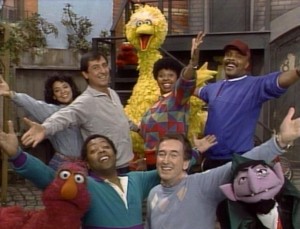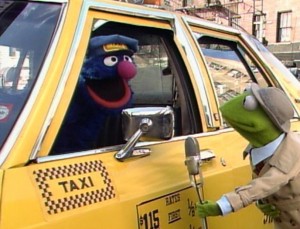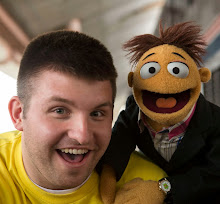 Mary Arline - Watching Sesame Street: 20 and Still Counting today is a little like opening up a time capsule. As Michael Davis says in his book, Street Gang: The Complete History of Sesame Street, "The nineties were a time of transition on Sesame Street, as the original architects and builders of the enterprise faced changes in the cultural landscape, trials on the show, and their own mortality." This 20th anniversary special, produced by Jim Henson and written by veteran Sesame scribes Tony Geiss and Judy Freudberg, captures Sesame Street at the cusp of this transitional phase, freezing it in time for the nostalgic pleasure of us "old school" Sesame fans, as well as for the benefit of those who missed this era completely.
Mary Arline - Watching Sesame Street: 20 and Still Counting today is a little like opening up a time capsule. As Michael Davis says in his book, Street Gang: The Complete History of Sesame Street, "The nineties were a time of transition on Sesame Street, as the original architects and builders of the enterprise faced changes in the cultural landscape, trials on the show, and their own mortality." This 20th anniversary special, produced by Jim Henson and written by veteran Sesame scribes Tony Geiss and Judy Freudberg, captures Sesame Street at the cusp of this transitional phase, freezing it in time for the nostalgic pleasure of us "old school" Sesame fans, as well as for the benefit of those who missed this era completely. Geiss and Freudberg do an excellent job of both showing and telling what makes Sesame Street so unique and effective. Informative, documentary-style segments--with related clips from the show itself--are interspersed with Muppet material original to the special. Bill Cosby is the host, and he was a great choice because he has both the scholarly credibility to deliver the informational narrative and the comedic chops to hold his own in the Muppet bits. In addition to the Muppets' interactions with Cosby, there are two recurring Muppet plot threads woven throughout the special: Bert and Ernie making their own home movie about Sesame Street, and Kermit the roving reporter trying to get ordinary citizens to answer the question of the day--"Can you tell me how to get to Sesame Street?"--and being repeatedly frustrated by Grover. These segments result in some vintage-quality Jim and Frank material.
Geiss and Freudberg do an excellent job of both showing and telling what makes Sesame Street so unique and effective. Informative, documentary-style segments--with related clips from the show itself--are interspersed with Muppet material original to the special. Bill Cosby is the host, and he was a great choice because he has both the scholarly credibility to deliver the informational narrative and the comedic chops to hold his own in the Muppet bits. In addition to the Muppets' interactions with Cosby, there are two recurring Muppet plot threads woven throughout the special: Bert and Ernie making their own home movie about Sesame Street, and Kermit the roving reporter trying to get ordinary citizens to answer the question of the day--"Can you tell me how to get to Sesame Street?"--and being repeatedly frustrated by Grover. These segments result in some vintage-quality Jim and Frank material.Among the highlights of this special are brief where-are-they-now interviews with now-grown Sesame kids John-John, Fannie, and Shola, a conversation between Sesame Street creator Joan Ganz Cooney and Jim Henson, a segment exploring the international co-productions, and four songs by Joe Raposo (the Sesame Street theme song, "Bein' Green" (performed by Ray Charles), "Sing") and two songs original to this special ("What a Bird" and "Look Through the Window"). Fittingly, this special is dedicated to Raposo, who died a few months before it aired.
 "What a Bird" is a song about Big Bird and how wonderful he is, sung by Big Bird himself. If I have one criticism to make about this special, it's that the lyrics to this song make it seem like Big Bird is dangerously close to crossing the line between healthy self-esteem and insufferable braggadocio. On the other hand, Big Bird IS every bit as wonderful as the song says he is, so in any case, it is immensely satisfying to see him get a celebratory musical montage. "Look Through the Window" is a beautiful duet sung by opera great Placido Domingo and his Muppet namesake, Placido Flamingo (performed by the late, great Richard Hunt) along with a chorus of Anything Muppets dressed to represent various world cultures. In spite of the inherent potential for silliness, it's one of the most poignant and heartfelt moments in the entire special. To this very day, this song gives me goosebumps every time I hear it. Another triumphant musical moment in the special is Ray Charles singing "Bein' Green" with a chorus of monsters. Is it blasphemous to say that this is my favorite rendition of "Bein' Green"? Well, it is. Sorry, Kermit.
"What a Bird" is a song about Big Bird and how wonderful he is, sung by Big Bird himself. If I have one criticism to make about this special, it's that the lyrics to this song make it seem like Big Bird is dangerously close to crossing the line between healthy self-esteem and insufferable braggadocio. On the other hand, Big Bird IS every bit as wonderful as the song says he is, so in any case, it is immensely satisfying to see him get a celebratory musical montage. "Look Through the Window" is a beautiful duet sung by opera great Placido Domingo and his Muppet namesake, Placido Flamingo (performed by the late, great Richard Hunt) along with a chorus of Anything Muppets dressed to represent various world cultures. In spite of the inherent potential for silliness, it's one of the most poignant and heartfelt moments in the entire special. To this very day, this song gives me goosebumps every time I hear it. Another triumphant musical moment in the special is Ray Charles singing "Bein' Green" with a chorus of monsters. Is it blasphemous to say that this is my favorite rendition of "Bein' Green"? Well, it is. Sorry, Kermit.There is an entire segment explaining the reasoning behind creating humor that appeals to both adults and children, complete with a montage of some of the show's notable pop culture references. It's interesting to watch this montage now because some of the references are iconic and timeless ("Monsterpiece Theater," "Squeal of Fortune") and others seem hopelessly dated ("Miami Mice," "The Word is No"). Throughout the special, Geiss and Freudberg further demonstrate the principle of two-tiered comedy in the original Muppet material, as with Bert's ironically scathing remark, "Who wants to see Sesame Street on TV?" and the introduction to "Look Through the Window," in which Placido Flamingo and Bill Cosby have the following exchange:
PLACIDO FLAMINGO: Excuse me, I have to meet someone.
COSBY: Really? Who are you meeting, Carmen?
PLACIDO FLAMINGO: Hahaha! Not today.
Now, that's not just a matter of comedy for adults versus comedy for kids. That joke is funniest to people readily familiar with the plots of 19th-century European opera, which I generously estimate to be less than 5% of the population. That's what makes Sesame Street one of the greatest shows on television; they don't underestimate their audience.
 Inevitably, there are lots of small moments in this special that are more significant or more poignant when viewed today. It is almost painfully bittersweet to watch this special knowing that, at the time that it aired, Jim Henson had only about a year left to live. Similarly, Richard Hunt and Northern Calloway both appear in this special (Calloway only briefly), and each of them would pass on, prematurely and tragically, within three years. Some of the international co-productions featured in the special are no longer extant, but it is particularly gut-wrenching to watch the scenes of the Kuwaiti version when you know that the show and its characters were essentially casualties of the 1990 Iraqi invasion.
Inevitably, there are lots of small moments in this special that are more significant or more poignant when viewed today. It is almost painfully bittersweet to watch this special knowing that, at the time that it aired, Jim Henson had only about a year left to live. Similarly, Richard Hunt and Northern Calloway both appear in this special (Calloway only briefly), and each of them would pass on, prematurely and tragically, within three years. Some of the international co-productions featured in the special are no longer extant, but it is particularly gut-wrenching to watch the scenes of the Kuwaiti version when you know that the show and its characters were essentially casualties of the 1990 Iraqi invasion. With that in mind, perhaps the biggest highlight of the special is the segment exploring the pivotal life events depicted on the show, such as Mr. Hooper's death and the wedding of Maria and Luis, both of which have often been anthologized elsewhere, as well as Miles' adoption and Big Bird learning of Maria's pregnancy. These latter two clips are more obscure. In fact, this special is the only place I've ever seen the scene in which newlyweds Luis and Maria inform Big Bird that they are expecting a baby, which is really too bad because it's one of the best examples I've ever seen of the respect with which Sesame Street regards its young audience. The explanation that Maria and Luis give to Big Bird's questions is completely straightforward and honest, and yet it doesn't tell Big Bird (or the audience) anything more than he needs to know. This segment and the segment on the death of Mr. Hooper illustrate beautifully the skill with which Sesame Street deals with sensitive subject matter; they lay a foundation of essential information which parents can then build upon as they see fit.
With that in mind, perhaps the biggest highlight of the special is the segment exploring the pivotal life events depicted on the show, such as Mr. Hooper's death and the wedding of Maria and Luis, both of which have often been anthologized elsewhere, as well as Miles' adoption and Big Bird learning of Maria's pregnancy. These latter two clips are more obscure. In fact, this special is the only place I've ever seen the scene in which newlyweds Luis and Maria inform Big Bird that they are expecting a baby, which is really too bad because it's one of the best examples I've ever seen of the respect with which Sesame Street regards its young audience. The explanation that Maria and Luis give to Big Bird's questions is completely straightforward and honest, and yet it doesn't tell Big Bird (or the audience) anything more than he needs to know. This segment and the segment on the death of Mr. Hooper illustrate beautifully the skill with which Sesame Street deals with sensitive subject matter; they lay a foundation of essential information which parents can then build upon as they see fit. But the most heartwarming moment of the special comes at the very end, when the entire cast sings Joe Raposo's masterpiece "Sing." It starts as a montage of characters singing, and as each character--Muppet and human--appears onscreen, the name of the performer shows along the bottom of the screen. This is a wonderful way of acknowledging and celebrating the work of the actors and the puppeteers alike. With that said, it becomes somewhat confusing because, while most of the puppeteers perform more than one character, each performer's name appears on the screen only once. So when Herry, Grover and Cookie Monster sing their bit, the caption only says "with David Rudman." Amusingly, at the time I wasn't familiar with "Caroll" as a man's name, so for a long time afterward I believed that Big Bird was performed by a woman. You can imagine my surprise when I finally saw Caroll Spinney on television as himself years later.
But the most heartwarming moment of the special comes at the very end, when the entire cast sings Joe Raposo's masterpiece "Sing." It starts as a montage of characters singing, and as each character--Muppet and human--appears onscreen, the name of the performer shows along the bottom of the screen. This is a wonderful way of acknowledging and celebrating the work of the actors and the puppeteers alike. With that said, it becomes somewhat confusing because, while most of the puppeteers perform more than one character, each performer's name appears on the screen only once. So when Herry, Grover and Cookie Monster sing their bit, the caption only says "with David Rudman." Amusingly, at the time I wasn't familiar with "Caroll" as a man's name, so for a long time afterward I believed that Big Bird was performed by a woman. You can imagine my surprise when I finally saw Caroll Spinney on television as himself years later.It is undeniable that, over the course of 43 years, Sesame Street has changed a lot. It is not my aim to make value judgments about whether the changes have been for better or worse. However, I think it's fair to say that some of the biggest, most visible changes to the show have been made since this special originally aired, and those changes can be quite jarring to those of us who watched Sesame Street in the '70s and '80s and not very often since. One segment in this special features adults who grew up watching Sesame Street, and one of them says, "I have a three-year-old son now, and he loves [Sesame Street], and I remember a lot of the stuff that he's still watching, and I can share it with him because I went through the same thing." Today, maybe parents in their 20s can still say that, but considerably fewer parents in their 30s and 40s could. Therefore, for those of us who experienced Sesame Street firsthand during its first 20 years, this special is more than a time capsule: it's like looking through a scrapbook or reminiscing with an old friend.
The Muppet Mindset by Ryan Dosier, muppetmindset@gmail.com
























I love this review thank you! One question though were can I buy and/or rent this? Thanks!
ReplyDeleteHugs and giggles~maria gayle
They released it on DVD a few years ago. I would probably try Amazon first.
Delete